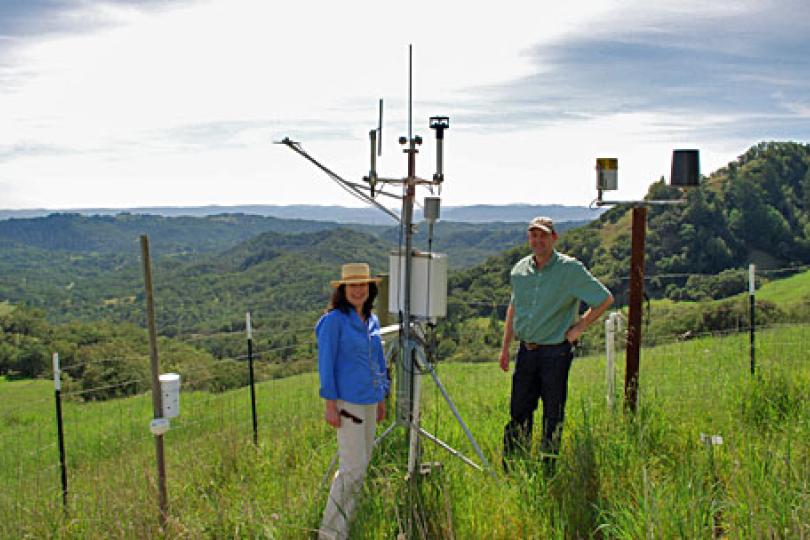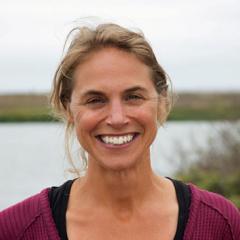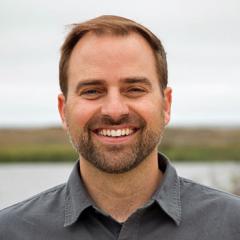Thinking Ahead about Climate Change in Sonoma County
Sonoma County in Northern California is one of the most proactive counties on both climate mitigation and adaptation in the country. One of just sixteen communities in the United States recognized as a Climate Action Champion by the White House in 2014, the Sonoma County Regional Climate Protection Authority (RCPA) is the nation’s first local government agency created specifically to address climate change.
We have a number of Fellows leading in Sonoma County, working to understand the impacts of climate change at a micro level and develop solutions to improve local resiliency to climate change impacts that could be rolled out nationally.
In 2007, Lisa Micheli (1993) had a “crisis of conscience” while working on a large restoration project on the Napa River in California. The largest and most detailed summary of climate change ever undertaken had just been released (IPCC Fourth Assessment Report) and the headline findings of the report were that “warming of the climate system is unequivocal”, and that most of that warming is due to an increase in greenhouse gas concentrations caused by people since the Industrial Revolution.
Micheli looked at the work she was doing on the Napa River and realized she and her colleagues were still planning conservation measures for the area based on historic water conditions. She says she realized, “We can’t keep doing this. We need to figure out how the future may be different, especially when we are spending $35 million on a restoration project.” Local information wasn’t available at that time, however. There were only global data sets in which her region was merged into an average for all of Northern California, rendering results meaningless for a place with such natural climate diversity.
She and Healy Hamilton (1991), an ecologist who works on the distribution of biodiversity across the planet, spent an intense weekend in Hamilton’s cabin in the Sierras, watching the snow melt and writing what Micheli now calls a “manifesto.” Their goal was to figure out how to scale down the data to see the impacts of climate change at the microclimate level, so they could then “fast forward” the scenarios to see what these local Bay Area habitats might look like for plant and animal populations in the future. That manifesto has guided Micheli’s work ever since and formed the basis of her vision when she became the Pepperwood Foundation’s first Executive Director two years later in 2009. Micheli pitched a vision of the Pepperwood Preserve, a 3,120-acre preserve just an hour from San Francisco, as a living laboratory, where the effects of climate change on an area rich in biodiversity could be studied in depth, and the Pepperwood Foundation agreed.
Micheli sees this kind of audacious thinking as one of her strengths as a leader. She says “going for the big idea and seeing if it flies” helped her launch a series of initiatives that took the manifesto from paper to practice in just a few years.
Out of that weekend also grew the project Micheli and Hamilton called “At the Water’s Edge” (watch our video about the project’s origins and our support of it) and eventually coalesced with a meeting of scientists who wanted to figure out what impacts climate change is having on habitats in the Bay Area. In 2011 the group was christened the Terrestrial Biodiversity Climate Change Collaborative (TBC3), with Micheli and Professor David Ackerly of UC Berkeley serving as co-chairs. The group has gone on to find a home at Pepperwood and to produce work that has deepened scientists’ understanding of how climate conditions are changing, and the impacts this has on ecosystems. In particular, the group is exploring what is happening in the ecology at Pepperwood Preserve as a model of larger regional climate change impacts. Studies of drought and extreme wet conditions, implications of heat and fire on the landscape, and even an ecological model of how vegetation is shifting in response to climate factors are just some of the projects they have undertaken. Last year Bay Nature magazine published an excellent overview of TBC3’s founding and work, which continues to attract new partners and funding.
One of those collaborators is Nicole Heller (2004), who is working on a number of case studies at the Pepperwood Preserve as the TBC3 Climate Adaptation Coordinator (funded by a Switzer Leadership Grant) to understand how drought and extreme wet conditions, heat and fire, and vegetation shifts might develop over the coming decades. Heller’s background as a biologist, climate scientist, teacher and communicator has given her a unique combination of abilities in understanding the data and working with practitioners on how to use it.
A central component of Micheli's and Heller’s work thus far has been to look at how water moves and is stored on the Preserve, developing a set of high-resolution climate hydrology scenarios for the San Francisco Bay Area in partnership with TBC3’s USGS affiliates. Through it and other projects, Pepperwood has become a long-term sentinel site to track climate change in real time, making it a living laboratory for measuring climate drivers, and testing adaptation strategies for conservation and grazing practices. Experiments can happen at the preserve and be monitored over time, and Micheli is there to steward it all.
This tie between the preserve, climate scientists and land managers has been critical to the success of the TBC3 work, Micheli believes. Forging new relationships takes time and “a lot of elbow grease,” she says. “The job is to do the work of creating pathways and having conversations we [scientists and land managers] don’t normally take the time to have. It takes time to do innovative cross-cutting work.”
In the end, she says, "You may have state and federal and international policies about mitigation, but adaptation has to happen locally. Building relationships over time is critical. Every time I try to bridge a big gap, it only works when I have long-term relationships with the people involved. That’s what we are building at Pepperwood.”
One of the best bits of mentoring she received early on was from our Executive Director, Lissa Widoff, who she says reminded her: “You’re serving as a backbone organization, the glue that keeps everyone together. You need a way to highlight the value of that work, because without a backbone, a multidisciplinary project like this one can’t work.”
But Micheli says this is time-intensive work, and people are always asking what needs to be done right now about climate change. Her real worry is that people will rush ahead and jump to conclusions before the data is fully evaluated. She says, “People want quick answers, but what we need is comprehensive monitoring. We don’t really know how the ecosystems are going to change and adapt. Some systems we may have to write off, and other systems may have native winners out of climate change.”
She strives to find a balance between staying pragmatic and feeling like we’ve already lost the whole game. When she looks at high resolution images, the challenges of climate change actually feel less dramatic, because they show both hot spots and refugia, places where plants and animals can “hide” from the stresses they are already encountering. She also thinks working locally has helped achieve results, because local agencies in Sonoma County are taking their work to prepare for climate change very seriously.
“Even though you have people here who are dubious of the human element of climate change, when you shift to talking about adapting to weather variability everyone wants to be involved,” says Micheli.
“In my work with the North Coast Resource Partnership, I work with a diverse set of people from all over the political spectrum – ranging from Bay Area progressives to members of the Tea Party” says Karen Gaffney (1999), the founder and CEO of West Coast Watershed and the Conservation Planning Manager at the Sonoma County Agricultural Preservation & Open Space District, a collaborative partner of Pepperwood. “I always try to get out of the echo chamber and think about what resonates with people who hold dramatically different values from me. How can I align everyone’s needs to come up with one policy or strategy? For example, some people may not believe in climate change, but if I talk about energy independence or forest health we can all get on the same page,” Gaffney says.
The District’s mission, to permanently protect the diverse agricultural, natural resource and scenic open space lands of Sonoma County for future generations, focuses on multiple benefits – many of which are aligned with climate mitigation and adaptation goals, Gaffney says. Conserving open space mitigates against climate change in several ways: reducing long commutes by concentrating development, maintaining forests that sequester carbon from the atmosphere, protecting wildlife corridors and biodiversity, and more.
Gaffney’s work is by necessity very data driven, with a strong emphasis on spatial analysis. She uses data from TBC3, NASA, economists as well as other sources in looking at long-term acquisition planning that can have the biggest impact on reducing greenhouse gas emissions in Sonoma County.
Gaffney has collaborated with local, state and national partners in an initiative entitled “Healthy Lands and Healthy Economies” to evaluate the multiple benefits associated with conservation of natural capital: water quality and supply, increased public health, better flood control, decrease in vehicle miles traveled, keeping carbon sequestered in redwoods on the coast, and more. “We are documenting the return on our conservation investments and how these benefits are aligned with societal goals” Gaffney says.
Fellow Tom Robinson (2014) is a colleague of Gaffney. In his role as Conservation Planner, he brings together scientists, state and local government staff, and NGO partners to integrate environmental data, fill critical information gaps, and develop adaptive spatial decision support systems to steer conservation policies and actions toward positive outcomes for resiliency.
He and Gaffney are working to provide an answer to the question: How do we demonstrate the significant link between intact ecosystems and community resiliency to climate change? Most people understand that communities depend on natural landscapes for clean water, air, and food, Robinson says. “But climate scientists tell us that intact ecosystems are more resilient to the effects of climate change and actually work to mitigate the effects of climate change by absorbing heat, energy, and excess carbon dioxide. They’ve also shown us how climate change is exacerbated by land clearing. So land conservation does triple duty by providing resources we need, mitigating climate change, and helping our communities withstand the coming changes. Climate change makes the job of conserving intact ecosystems that much more critical,” Robinson says, noting “it is less expensive to conserve existing intact landscapes than attempting to piece them back together once they are fragmented.”
Robinson, Gaffney and colleagues at The Nature Conservancy have been working on a project using remote sensing data from NASA, the University of Maryland, and other institutions, to look at how much carbon from the atmosphere can be sequestered in natural areas over time. Robinson and Gaffney seek to understand how much carbon could be stored in trees, soil and other biomass. They can use this data to assess how their land conservation efforts could contribute to California’s greenhouse gas emissions reduction targets by allowing sequestration to continue and avoiding the emissions associated with clearing natural vegetation. Using the data, they will construct various scenarios of land use to show the difference between “business as usual” sequestration rates and rates when investment in conservation is increased. This gets them a huge step closer to demonstrating how local land conservation can help California meet its aggressive greenhouse gas emissions reduction goals-- and tapping into the $500 million per year of funding that resulted from AB 32, some of which Gaffney and Robinson would like to see used to fund local land conservation statewide.
"Funds should be directed toward conserving land because doing so not only reduces greenhouse gas emissions, but offers the additional benefits of protecting groundwater, preserving scenic values, protecting biodiversity, and enhancing food production. Once people begin to understand how their surrounding landscape is working for them in these ways, they may come to view conservation as an essential public investment,” says Robinson, echoing similar sentiments from Lisa Micheli and Karen Gaffney.
Micheli, Heller, Gaffney and Robinson also share a belief that their work in Sonoma County could act as a model for linking carbon sequestration and land conservation that can be exported to other counties. They believe that leadership and workable solutions at the local level will have the greatest positive impact on community resilience and conservation in the face of a changing climate.



